Building your own Microphone for Analyzing & Testing Speakers
To test your speaker system you will need a microphone, a computer with a microphone input and speaker/headphone output, and some custom analysis software. There are many expensive microphones and software solutions out there. This article attempts to help you test your speaker system as cheap as possible by using free software and a hand built microphone. Check out our page on Speaker Testing once you have constructed your microphone.
If you search on-line for a calibrated microphone, you will see they range from $50 to over $1000. You can make your own microphone with similar qualities for as little as $10. The biggest problem with making your own microphone is that you will not have any way to calibrate it without an already calibrated microphone or tone generator. Still, an uncalibrated microphone can be very accurate 5,000 Hz and below and can easily be used to identify response spikes at any frequency. If you aren't interested in building your own microphone, then you may want to check out the combined calibrated microphone + software deal from True Audio.
First, you want to order a Microphone Cartridge. DigiKey used to be the best place on-line to get parts to build your microphone, but you may want to also try Newark or MCM Electronics
Some of these electronics parts suppliers websites like Digikey and Newark can be difficult to use. First search for microphone cartridge or Panasonic microphone. Instead of a list of matches you may be presented with a list of categories. Select Microphones or Transducers microphones from that list. Finally you will see a list of many microphones with some filters at the top. Look for microphones with a 20Hz - 20k Hz (20 - 20,000 Hz) Frequency Response which is the range of human hearing and the typical response of a speaker. You will also want to look for microphones with a rated Voltage of 2V, a Current of 500uA, and an Impedance of 2.2K Ohms. Also, be sure to filter only In Stock items to remove old obsolete items.
I used the P9925-ND (WM-61A) microphone ($1.92) for these tests, but that microphone may no longer be available. If there are multiple models available, choose the one with the best (highest) Signal to Noise Ratio (S/N Ratio), and the best sensitivity. For example: the P9925-ND has a sensitivity of -35dB ±4dB and S/N Ratio of 62dB. The obsolete P9959-ND has a sensitivity of -42dB ±3dB and S/N Ratio of 58dB. The ±3dB error from the P9959 is better than the ±4dB error from the P9925, but P9925 has better sensitivity and less noise.
These microphones are very small as you can see from the images below. Making your own microphone requires that you be able to solder wire to the two solder pads on the back of the microphone. You may want to order several microphones to account for mistakes. At under $2 each, you will be paying more for shipping than the microphone itself anyway.
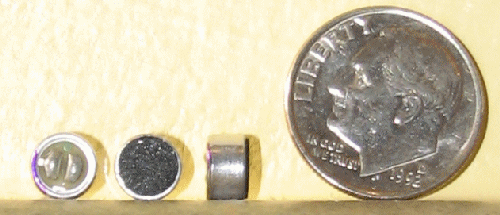
Here is a larger view. Notice the area outlined in blue on the left side of the microphone cartridge. This is a drop of solder that connects the negative (-) terminal to the frame of the microphone. (Read more at the end of this article on moving this bridge to the + terminal to improve the microphone quality.) When soldering the wires to the 2 solder pads, for the left (-) terminal realize that you can solder the wire anywhere in the area outlined in green. It doesn't matter if you get solder on the outer frame of the microphone, because the frame is already connected to the (-) terminal. This made it a lot easier for me to connect the 2 wires to the microphone because they didn't have to be that close together.
- (+) & (-) Solder Pads
- Bridge from Microphone Frame to (-) Solder Pad
- Purple paint to indicate Ground side
- Target area for solder point
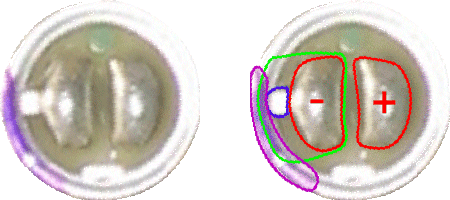
I used a shielded 22 gauge wire that I had lying around. You may want to use a thinner wire to make the soldering easier. You can see the black wire is much closer to the edge of the microphone since it didn't matter that the solder got on the edge of the microphone. I later connected the shield wire to the black (-) conductor. I didn't bother with shrink tube on the individual wires. The exposed wire is too short and covered in solder and there was no way the white and black wires could touch. You should also use a multimeter to test resistance to make sure the + and - terminals are not connected by some stray solder.
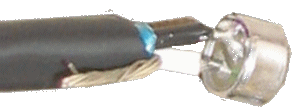
Now we need to connect a microphone plug to the other side of the wire. There are 2 options here. The first is to purchase a microphone cable and cut off one end. Then you have one end already wired with the microphone plug and you just connect the other end to the microphone cartridge. This can be a cheap and simple solution. It is also a good solution if the connectors on your computer are close together and the plug needs to be small. These molded cables are much smaller than the solder type connectors.
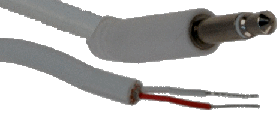
I went with a separate connector for this experiment. You can get 1/8" (3.5mm) Mono Mini Phone Plugs from DigiKey or Radio Shack. They look something like this.

Notice the small holes at the end of each connector. I like to run the wires through these holes, twist them and then solder. This makes for a much better connection. Remember to slide the plastic cover over the wire before soldering. Also, the left side of the longer terminal (with the teeth) is used for a strain relief. Crimp the non-stripped portion of the wire with this.

The final step was to use shrink tube to cover up the exposed wires on the microphone side. Here is the final result.
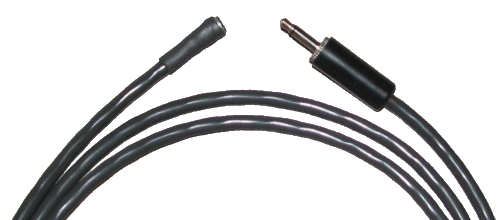
Now for a trick recommended by Linkwitz (of Linkwitz-Riley). You can decrease the microphone distortion at higher SPL levels and slightly increase the accuracy of the microphone by grounding the microphone frame to the positive (+) terminal instead of the negative (-) terminal. To do this, you will need to remove the bead of solder connecting the negative (-) terminal to the microphone frame - as outlined in blue in the previous image. You can see in the image below that I thoroughly scraped the area between the outer frame and the negative (-) terminal to make sure there was no remaining connection. Test resistance with a multimeter to be sure that you have completely removed all the solder. Once the solder is removed, connect the right positive (+) solder pad to the outer frame of the microphone cartridge.
- (+) & (-) Solder Pads
- New Bridge to add from Microphone Frame to (+) Solder Pad
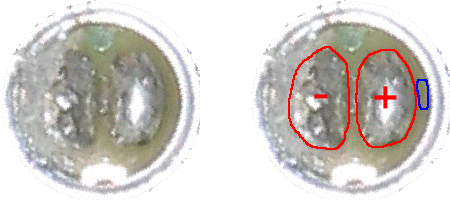
Once you have moved this bridge, follow the rest of the directions above as normal. The positive and negative solder pads are still the same. They did not swap just because you moved the frame connection from the negative to the positive terminal.
Another improvement you might want to make is to create a shotgun microphone using an aluminum tube. Shotgun microphones are very directional, blocking out most sound from the rear and sides. They are ideal for speaker testing to reduce the effect of reflections in the room where you are doing your testing.

A normal shotgun microphone has the microphone at one end of a long tube (6" or more) with slots cut along the sides the tube. You can get almost the same effect by using a hollow aluminum tube and placing your microphone cartridge at the end of the tube. The Panasonic microphones above are 6mm wide, so the Inside Diameter (ID) of the tube must be at least that wide. After cutting the tube use a metal file on the interior and exterior of each cut to remove any protrusions and sharp edges. You can find aluminum tubes at your local hardware store. Don't permanently attach the tube to the microphone. Shotgun microphones cannot be used for some types of in-room listening tests.

Now that you have your microphone, use it to test your speakers.